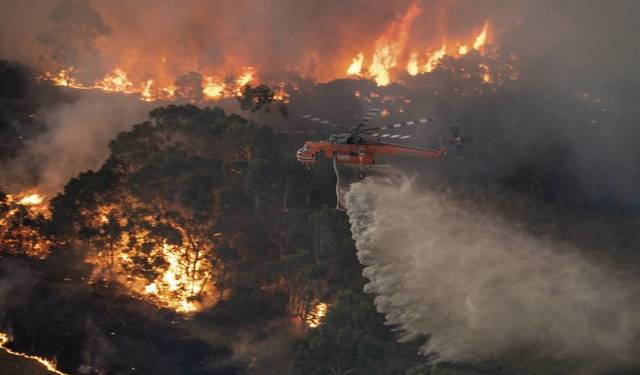Australia is burning at a rapid pace and that will have widespread ramifications for the entire world. The internet has been flooded with images of desperate Kangaroos frantically running away from the bushfires in a bid to save their lives. Koala bears have borne most of the brunt of the bush fires and in a piece of heartbreaking news, the species who had been declared “functionally extinct” in November might have been entirely wiped out. Over 24 people have died as a result of the relentless fires and worryingly, over a billion animals have met a fiery end. What’s more concerning is the fact that the figure of one billion is a conservative figure, with the likely number of animals who have succumbed to the fires much more than one billion.
The Australia bushfires highlight the urgent need to address Climate Change before it’s too late. To put things to perspective, over a billion animals close to India’s total population have been wiped out. While most of the world experiences winter around this time, for Australia its summertime and that’s where it all started. Australia usually goes through a fire season during their warmer months because the hot, dry weather and wind makes it easy for flames to spread. This year, the combination of 40 degrees Celsius temperatures and strong winds has caused the fires to spread. Scientists have said there’s no doubt man-made global warming has played a significant role in feeding the wildfires. The bushfires are often started by natural causes such as lightning strikes, however, humans are also sometimes to blame. According to The Sydney Morning Herald, New South Wales police have taken legal action against 183 people and have charged 24 people with deliberately starting bushfires this fire season. Every Australian state is experiencing fires currently with New South Wales and Victoria alone have over 200 fires burning.
More than 6.3 million hectares (63,000 sq km or 15.6 million acres) have been burned so far – one hectare is roughly the size of a sports field. Firefighters are spraying water and fire retardant from planes and helicopters as well as from the ground. But fighting bush fires is extremely difficult and often authorities have to focus on just stopping the spread, rather than putting the fire out. The spread can, for instance, be contained by digging earth boundaries to stop the flames from spreading.
The priority is saving lives. The fires aren’t going to stop anytime soon and will continue to wreak havoc in Australia for the foreseeable future. The fact why the figure of one billion animals who have succumbed to the fires is because even those fortunate to have survived have seen their habitat entirely destroyed, leaving the survivors vulnerable even once the fires have gone. So the true scale of loss isn’t yet clear.
The bushfires will have a massive impact on the global environment in the weeks to come. In a concerning development, smoke from Australia fires has reached as far as South America. Smoke from bushfires in Australia has travelled some 11,000 kilometres (6,800 miles) to South America. Last week, the highest levels of carbon monoxide in the world were measured over the “clean” South Pacific Ocean. In Geneva, the UN World Meteorological Organization (WMO) spokeswoman Clare Nullis told reporters the smoke had “probably” reached the Antarctic.
Haunting pictures of cute koalas, kangaroos and wallabies that have died en masse tear at our heartstrings as images surface of baby koalas, their fur singed, cling to their mothers as they face a fiery demise and military helicopters whomp overhead, searching the charred landscape for stragglers looking for a last-minute escape. While billions of dollars would be required to reconstruct the physical damage, the fires will also have a devastating impact on the mental health of the Australians. “Their national psyche will change,” says California-based psychotherapist Diane Ross-Glazer, who has counselled disaster survivors and lived through wildfires herself. “You’re not only grieving what you lost; you’re grieving for your country.” The trauma of any kind can result in lingering distress not only for direct sufferers but also for those who witness or read about a disaster or tragedy. Natural disasters and climate-change-induced extreme weather fall into this category, according to the American Psychological Association (APA). An Australian study published in 2014 found that about three years after the so-called Black Saturday bushfires killed 173 people and levelled huge swaths of land, more than 15% of respondents in heavily affected areas reported probable PTSD associated with the fires, while 13% reported depression and almost 25% reported heavy drinking. Of the 10% of respondents who said they had “severe” psychological distress, a third said they had not seen a mental health professional in the prior month.
The world must turn its attention to Australia and help the country out in any way possible because it’s not just the Australians fighting the fires, it’s the entire human civilisation fighting for their future. If urgent steps aren’t taken to contain the climate change, another tragedy of this level is only a matter of time, which might as well be the end of Earth as we know it.


































